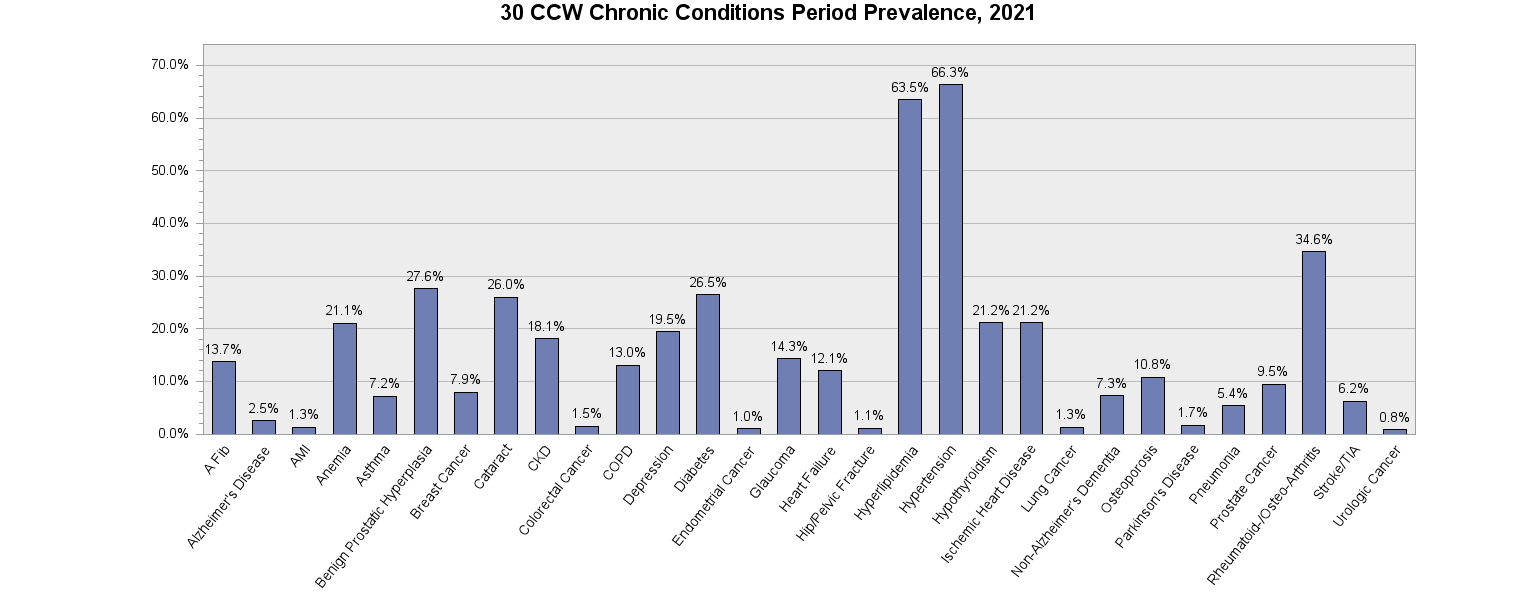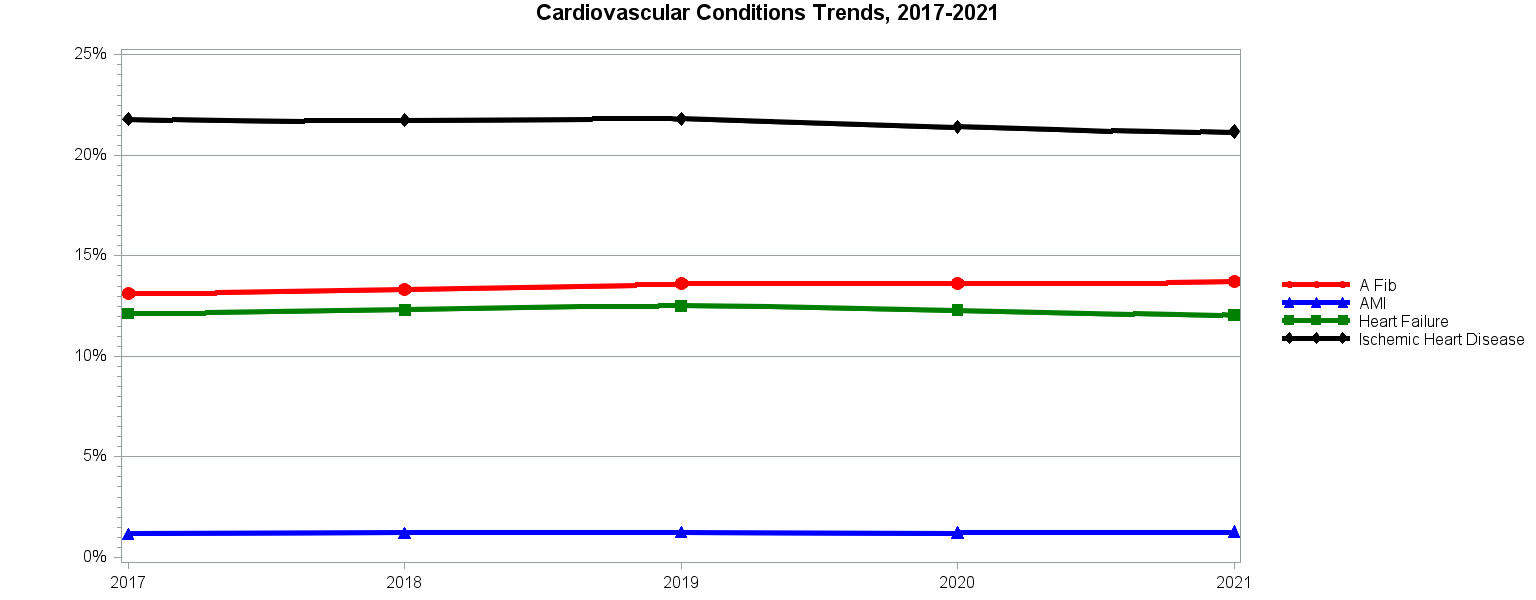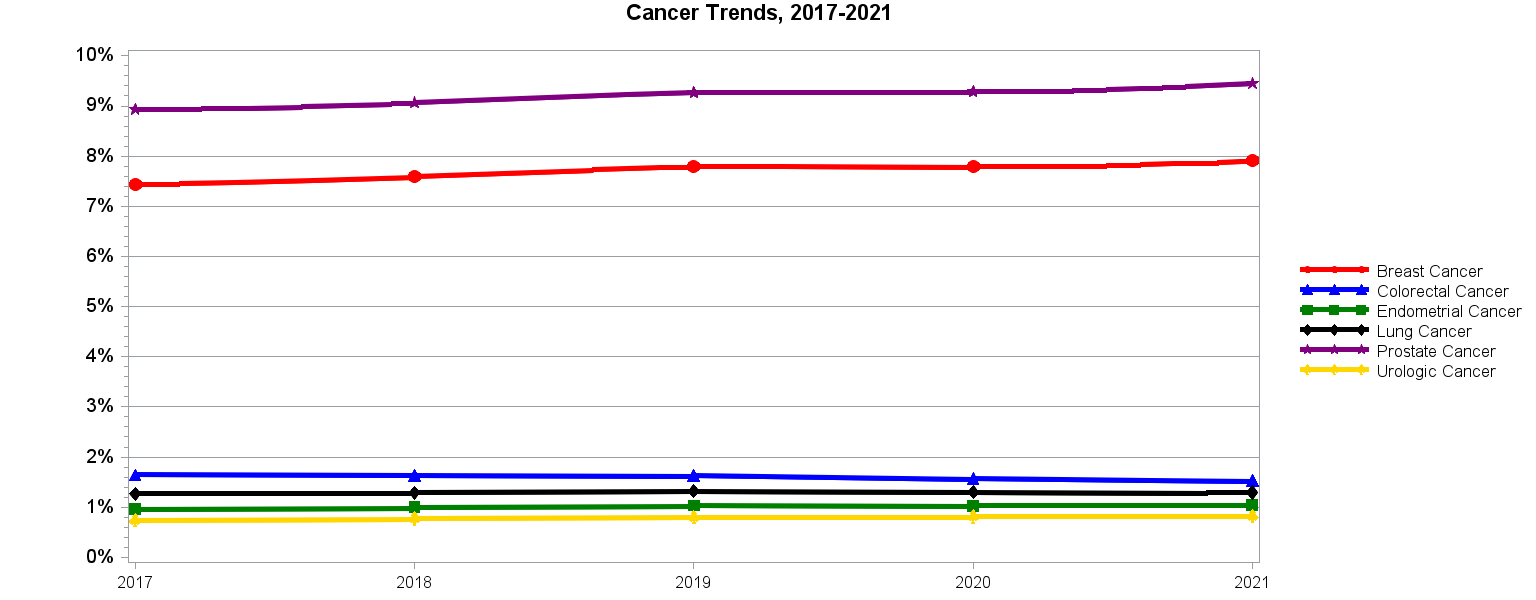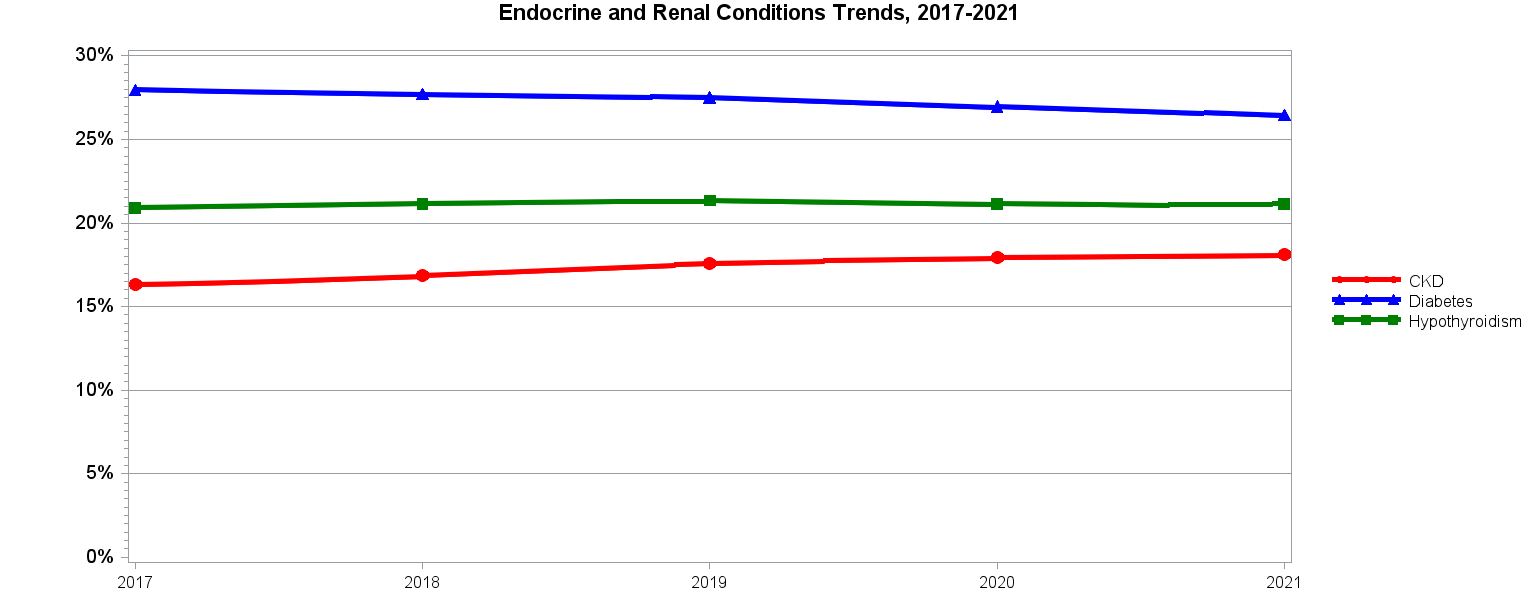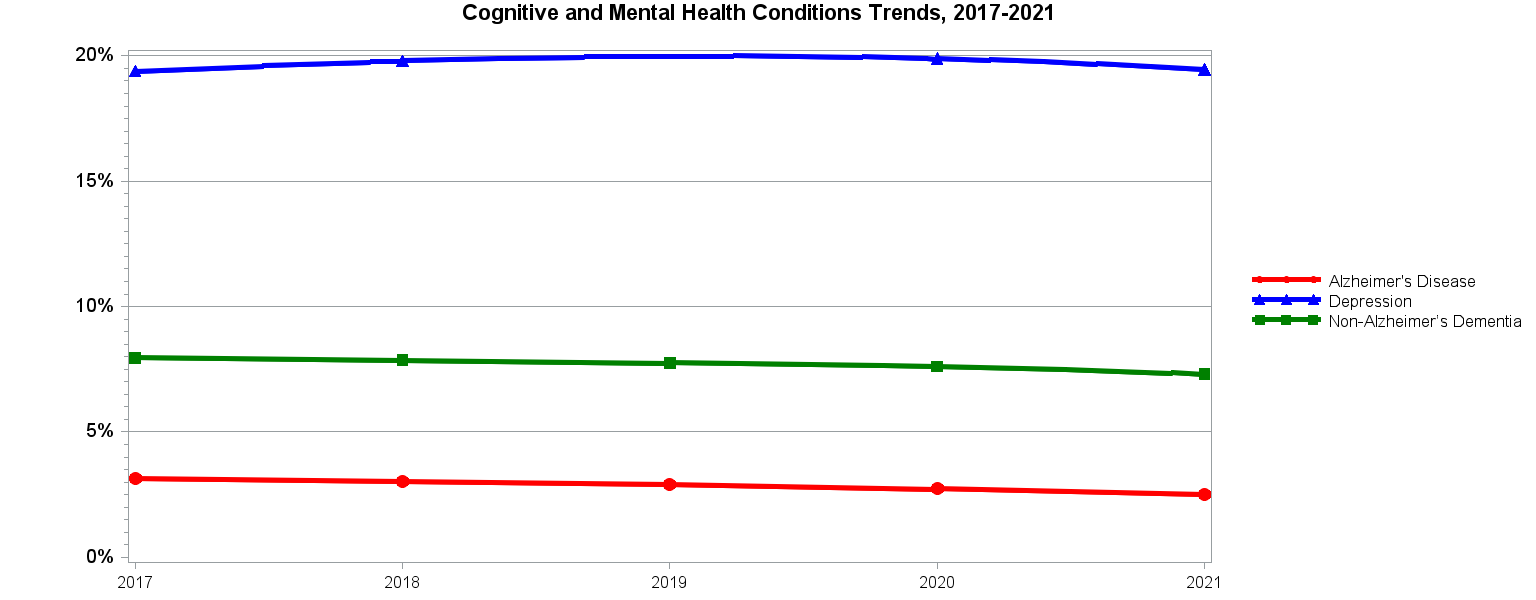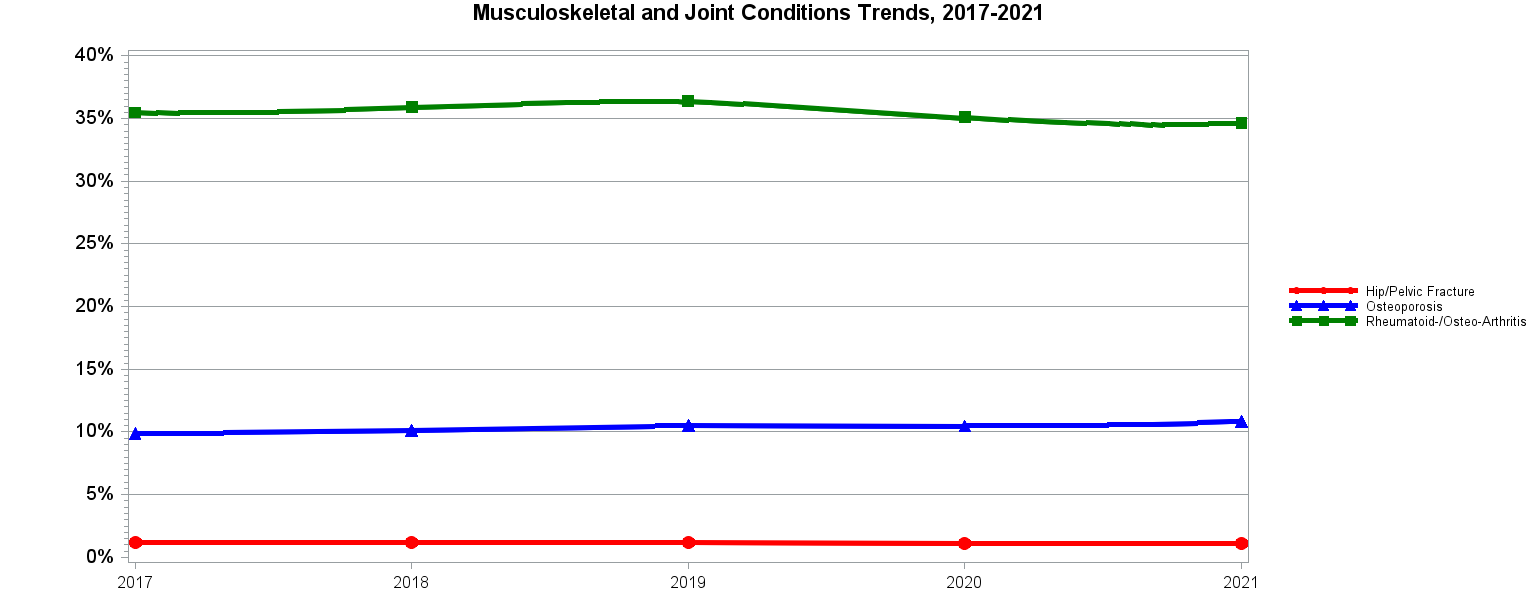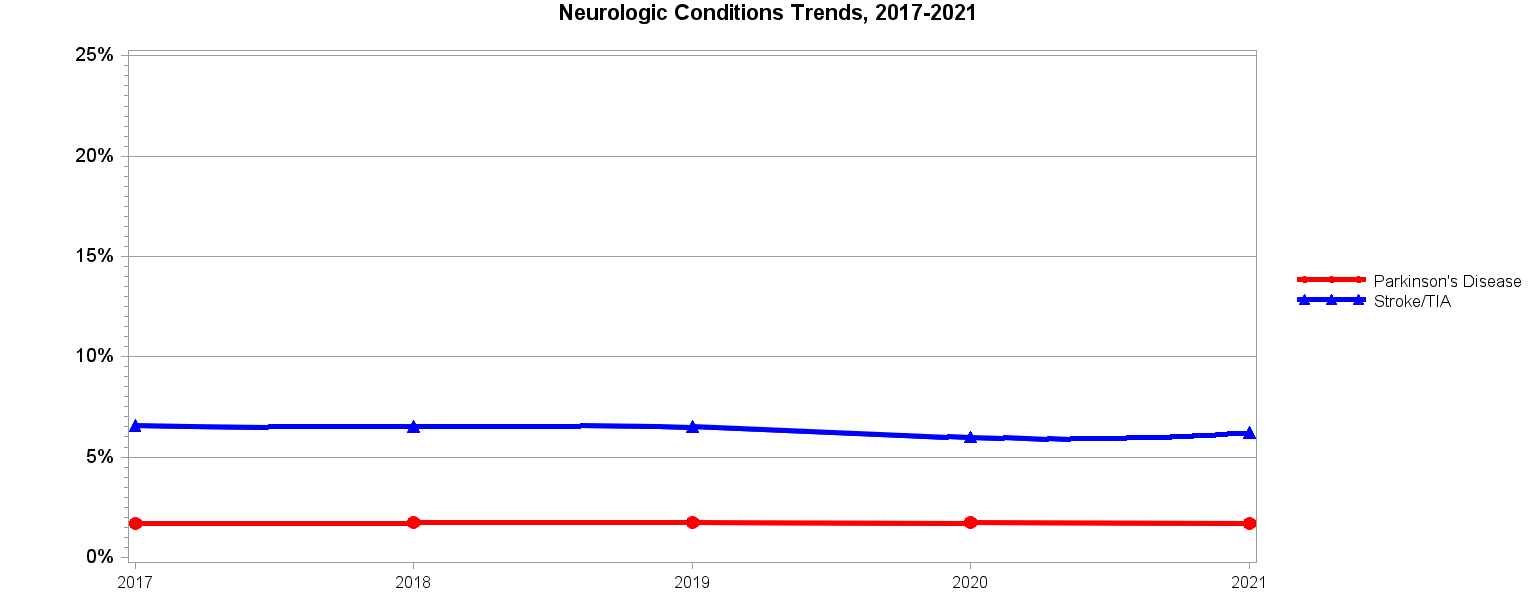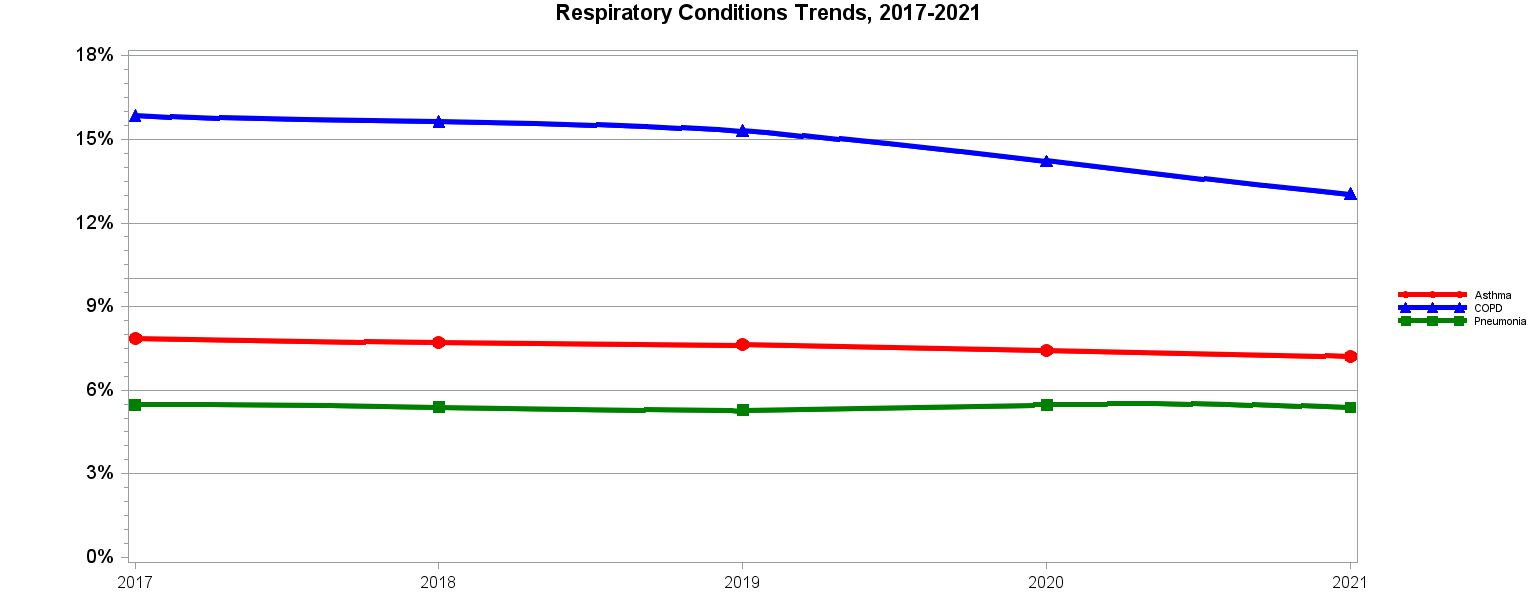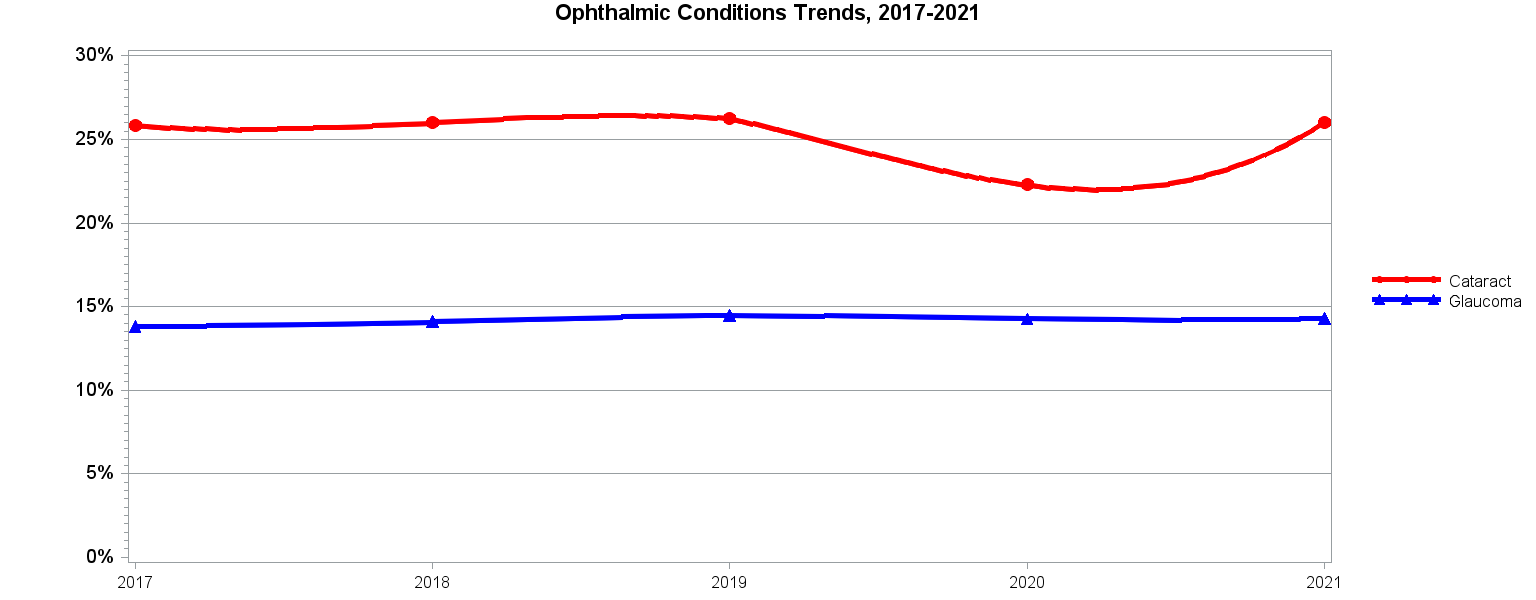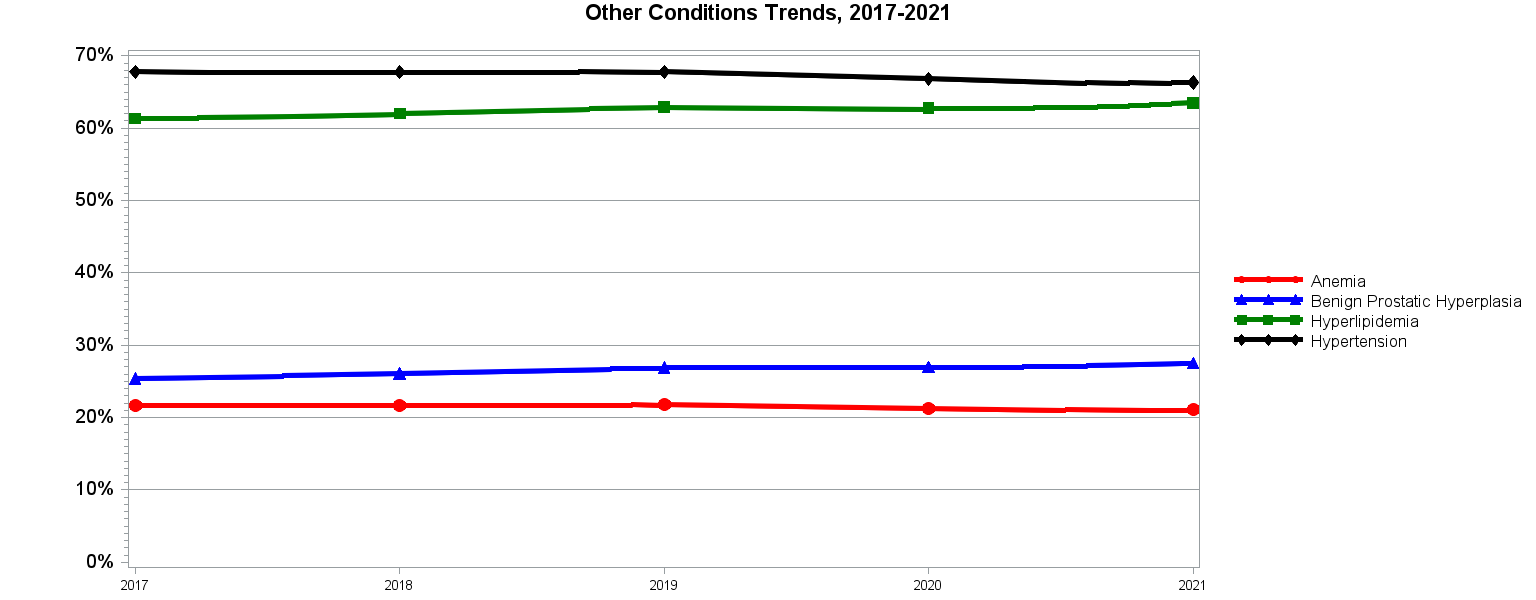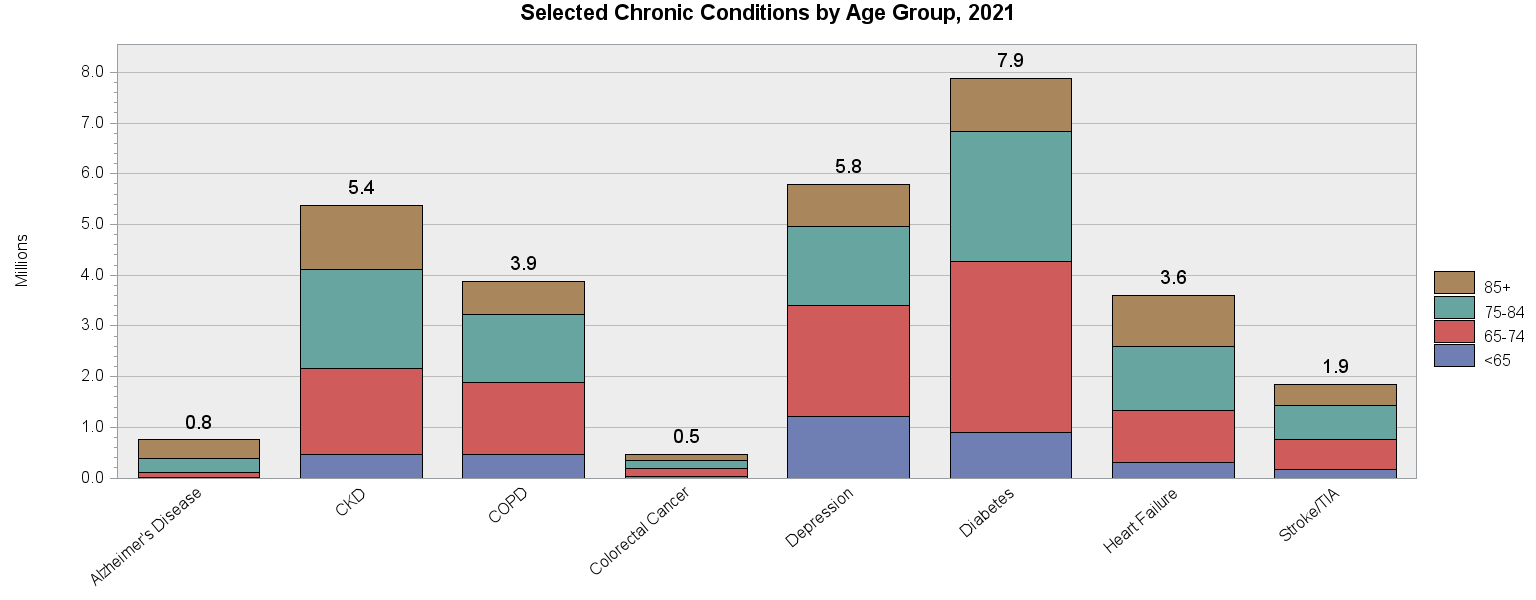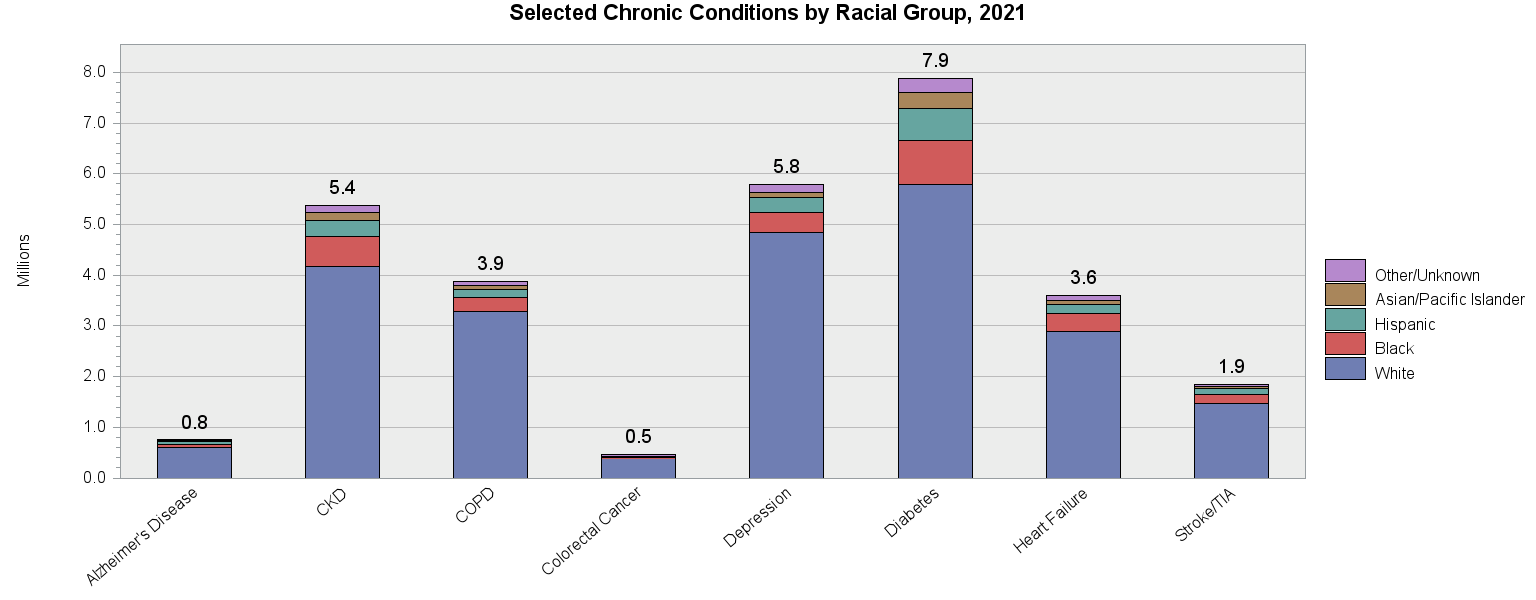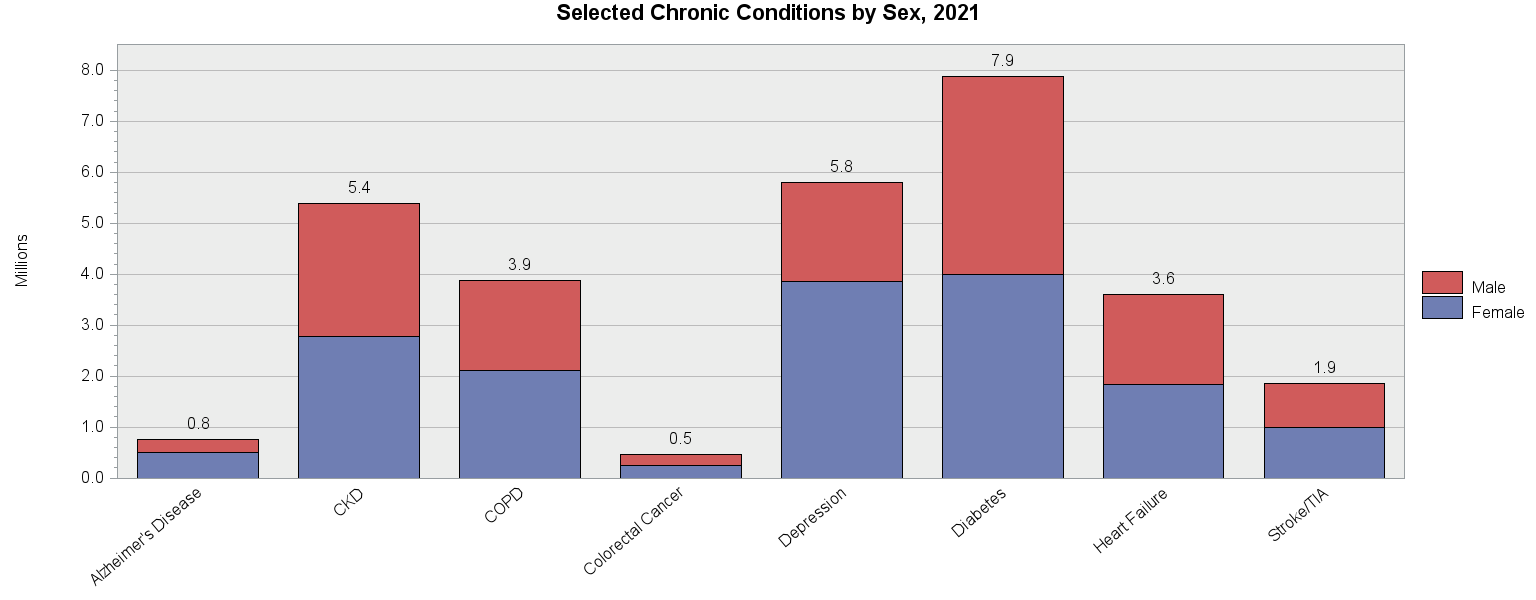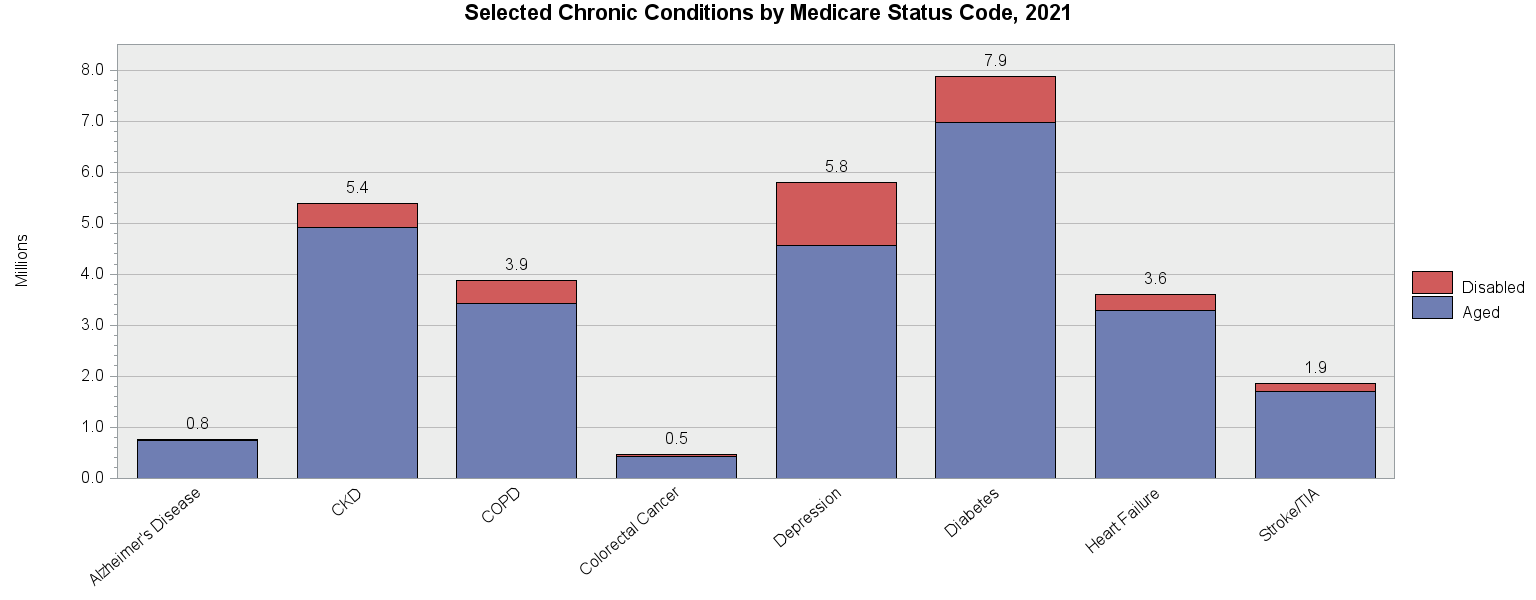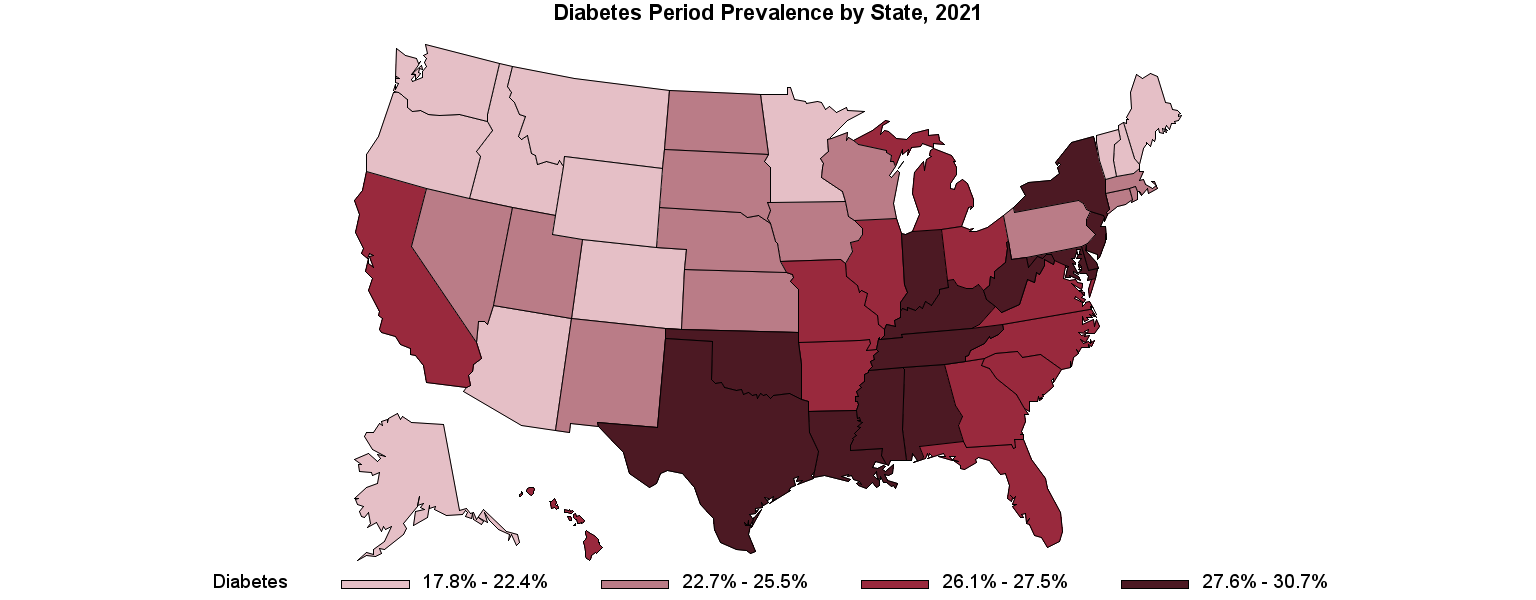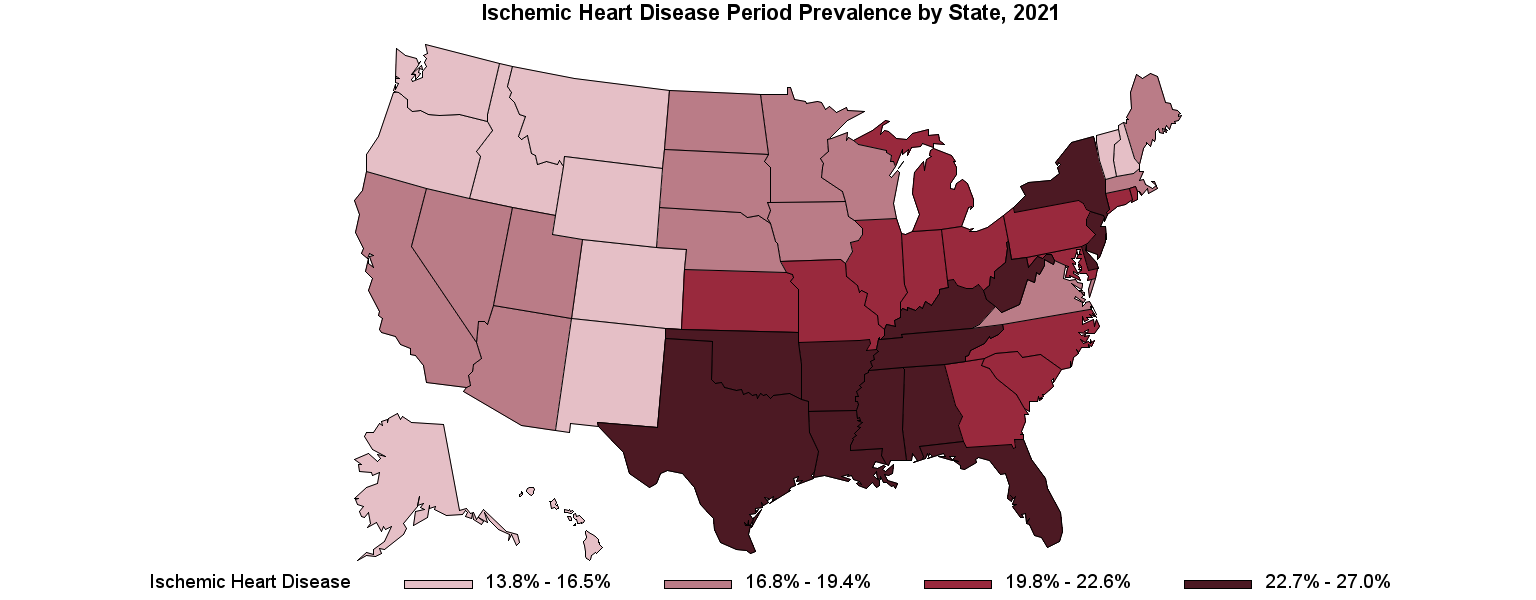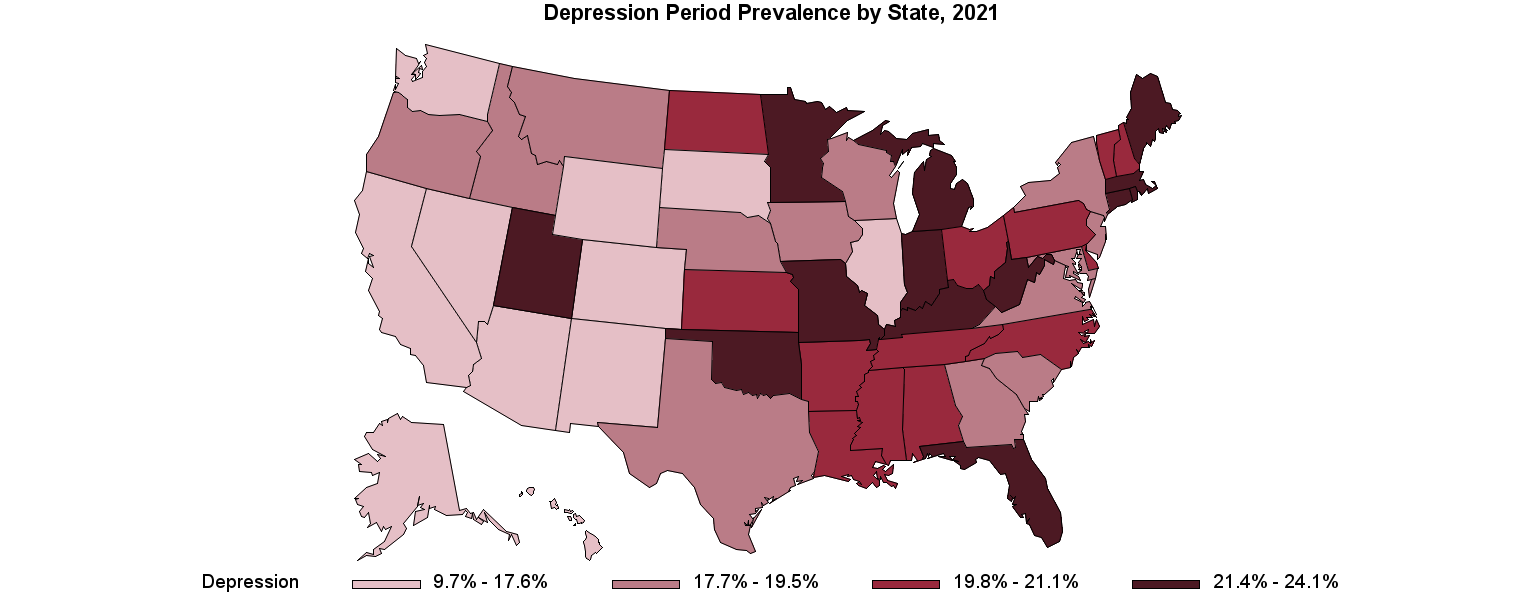Medicare Chronic Condition Charts
30 CCW Chronic Conditions Period Prevalence, 2021
Trends, 2017 - 2021:
- Cardiovascular Conditions
- Cancer
- Endocrine and Renal Conditions
- Cognitive and Mental Health Conditions
- Musculoskeletal and Joint Conditions
- Neurologic Conditions
- Respiratory Conditions
- Ophthalmic Conditions
- Other Conditions
Selected Chronic Conditions by:
Period Prevalence:
- Diabetes, 2021
- Ischemic Heart Disease, 2021
- Depression, Bipolar, or Other Depressive Mood Disorders, 2021
30 CCW Chronic Conditions Period Prevalence, 2021
Description:
The conditions with the highest period prevalence rates are hypertension (66.3%), hyperlipidemia (63.5%), and rheumatoid arthritis or osteoarthritis (34.6%).
Technical Notes:
Period prevalence is calculated for these rates. Beneficiaries with full or nearly full fee-for-service (FFS) coverage during the year who had FFS claims for the condition within the condition-specific look back period. Chronic conditions have a one- to two-year look-back time period. Please refer to the CCW website to obtain the algorithm criteria for these chronic conditions. Denominator is all who were enrolled in Medicare on or after January 1, 2021, and had full or nearly full FFS coverage (i.e., 11 or 12 months of Medicare Part A and B [or coverage until time of death] and one month or less of health maintenance organization [HMO] coverage). Only females are included in the numerator and denominator for endometrial and female breast cancer; only males are included for prostate cancer and benign prostatic hyperplasia. Beneficiaries may be counted in more than one condition category.
Chart Date: April 2023
Cardiovascular Conditions Trends, 2017–2021
Description:
The rates for the cardiovascular conditions have been stable over time, with a slight decrease in ischemic heart disease from 21.8% in 2017 to 21.2% in 2021. Atrial fibrillation and flutter(A fib) has increased slightly from 13.1% in 2017 to 13.7% in 2021.
Technical Notes:
Period prevalence is calculated for these rates. Beneficiaries with full or nearly full fee-for-service (FFS) coverage during the year who had FFS claims for the condition within the condition-specific look back period. Chronic conditions have a one- to two-year look-back time period. Please refer to the CCW website to obtain the algorithm criteria for these chronic conditions. Denominator is all who were enrolled in Medicare on or after January 1, 2021, and had full or nearly full FFS coverage (i.e., 11 or 12 months of Medicare Part A and B [or coverage until time of death] and one month or less of health maintenance organization [HMO] coverage). Beneficiaries may be counted in more than one condition category.
Chart Date: April 2023
Cancer Trends, 2017–2021
Description:
The rate for female breast cancer has risen slightly from 7.4% in 2017 to 7.9% in 2021; the rate for prostate cancer has increased slightly from 8.9% in 2017 to 9.46% in 2021. The rates for urologic, endometrial, lung, and colorectal cancer were stable over time.
Technical Notes:
Period prevalence is calculated for these rates. Beneficiaries with full or nearly full fee-for-service (FFS) coverage during the year who had FFS claims for the condition within the condition-specific look back period. Chronic conditions have a one- to two-year look-back time period. Please refer to the CCW website to obtain the algorithm criteria for these chronic conditions. Denominator is all who were enrolled in Medicare on or after January 1, 2021, and had full or nearly full FFS coverage (i.e., 11 or 12 months of Medicare Part A and B [or coverage until time of death] and one month or less of health maintenance organization [HMO] coverage). Only females are included in the numerator and denominator for endometrial and female breast cancer; only males are included for prostate cancer. Beneficiaries may be counted in more than one condition category.
Chart Date: April 2023
Endocrine and Renal Conditions Trends, 2017–2021
Description:
The proportion of the population being treated for diabetes changed from 28.0% in 2017 to 26.46% in 2021. The period prevalence rate of chronic kidney disease (CKD) has risen from 16.3% in 2017 to 18.09% in 2021. Acquired hypothyroidism increased from 20.9% in 2017 to 21.16% in 2021.
Technical Notes:
Period prevalence is calculated for these rates. Beneficiaries with full or nearly full fee-for-service (FFS) coverage during the year who had FFS claims for the condition within the condition-specific look back period. Chronic conditions have a one- to two-year look-back time period. Please refer to the CCW website to obtain the algorithm criteria for these chronic conditions. Denominator is all who were enrolled in Medicare on or after January 1, 2021, and had full or nearly full FFS coverage (i.e., 11 or 12 months of Medicare Part A and B [or coverage until time of death] and one month or less of health maintenance organization [HMO] coverage). Beneficiaries may be counted in more than one condition category.
Chart Date: April 2023
Cognitive and Mental Health Conditions Trends, 2017–2021
Description:
The prevalence of treatment for Alzheimer’s disease decreased from 3.1% in 2017 to 2.52% in 2021; the prevalence also decreased for non-Alzheimer’s dementia from 8.0% in 2017 to 7.32% in 2021. The rate of treatment for depression has been stable over time.
Technical Notes:
Period prevalence is calculated for these rates. Beneficiaries with full or nearly full fee-for-service (FFS) coverage during the year who had FFS claims for the condition within the condition-specific look back period. Chronic conditions have a one- to two-year look-back time period. Please refer to the CCW website to obtain the algorithm criteria for these chronic conditions. Denominator is all who were enrolled in Medicare on or after January 1, 2021, and had full or nearly full FFS coverage (i.e., 11 or 12 months of Medicare Part A and B [or coverage until time of death] and one month or less of health maintenance organization [HMO] coverage). Beneficiaries may be counted in more than one condition category.
Chart Date: April 2023
Musculoskeletal and Joint Conditions Trends, 2017–2021
Description:
The rate of hip or pelvic fractures has been stable over time. The rate of treatment for osteoporosis increased from 9.9% in 2017 to 10.83% in 2021. The rate of treatment for rheumatoid or osteoarthritis decreased from 35.5% in 2017 to 34.64% in 2021.
Technical Notes:
Period prevalence is calculated for these rates. Beneficiaries with full or nearly full fee-for-service (FFS) coverage during the year who had FFS claims for the condition within the condition-specific look back period. Chronic conditions have a one- to two-year look-back time period. Please refer to the CCW website to obtain the algorithm criteria for these chronic conditions. Denominator is all who were enrolled in Medicare on or after January 1, 2021, and had full or nearly full FFS coverage (i.e., 11 or 12 months of Medicare Part A and B [or coverage until time of death] and one month or less of health maintenance organization [HMO] coverage). Beneficiaries may be counted in more than one condition category.
Chart Date: April 2023
Neurologic Conditions Trends, 2017–2021
Description:
The rate of treatment for Parkinson's Disease has been stable over time. The rate of treatment for stroke or Transient Ischemic Attack (TIA) decreased slightly from 6.6% in 2017 to 6.23% in 2021.
Technical Notes:
Period prevalence is calculated for these rates. Beneficiaries with full or nearly full fee-for-service (FFS) coverage during the year who had FFS claims for the condition within the condition-specific look back period. Chronic conditions have a one- to two-year look-back time period. Please refer to the CCW website to obtain the algorithm criteria for these chronic conditions. Denominator is all who were enrolled in Medicare on or after January 1, 2021, and had full or nearly full FFS coverage (i.e., 11 or 12 months of Medicare Part A and B [or coverage until time of death] and one month or less of health maintenance organization [HMO] coverage). Beneficiaries may be counted in more than one condition category.
Chart Date: April 2023
Respiratory Conditions Trends, 2017–2021
Description:
Prevalence of treatment for chronic obstructive pulmonary disease (COPD) has decreased from 15.9% in 2017 to 13.1% in 2021. The period prevalence for asthma decreased from 7.9% in 2017 to 7.2% in 2021. The prevalence of treatment for all-cause pneumonia has been stable over time.
Technical Notes:
Period prevalence is calculated for these rates. Beneficiaries with full or nearly full fee-for-service (FFS) coverage during the year who had FFS claims for the condition within the condition-specific look back period. Chronic conditions have a one- to two-year look-back time period. Please refer to the CCW website to obtain the algorithm criteria for these chronic conditions. Denominator is all who were enrolled in Medicare on or after January 1, 2021, and had full or nearly full FFS coverage (i.e., 11 or 12 months of Medicare Part A and B [or coverage until time of death] and one month or less of health maintenance organization [HMO] coverage). Beneficiaries may be counted in more than one condition category.
Chart Date: April 2023
Ophthalmic Conditions Trends, 2017–2021
Description:
The proportion of Medicare beneficiaries with a cataract procedure decreased in 2020 and has reverted to typical pattern in 2021. The rate of cataract procedures declined from 26.3% in 2019 to 22.3% in 2020, and then returned to 25.99% in 2021. The proportion of beneficiaries identified as having treatment for glaucoma increased from 13.8% in 2017 to 14.3% in 2021.
Technical Notes:
Period prevalence is calculated for these rates. Beneficiaries with full or nearly full fee-for-service (FFS) coverage during the year who had FFS claims for the condition within the condition-specific look back period. Chronic conditions have a one- to two-year look-back time period. Please refer to the CCW website to obtain the algorithm criteria for these chronic conditions. Denominator is all who were enrolled in Medicare on or after January 1, 2021, and had full or nearly full FFS coverage (i.e., 11 or 12 months of Medicare Part A and B [or coverage until time of death] and one month or less of health maintenance organization [HMO] coverage). Beneficiaries may be counted in more than one condition category.
Chart Date: April 2023
Other Conditions Trends, 2017–2021
Description:
The period prevalence of beneficiaries who had fee-for-service claims for hyperlipidemia increased from 61.3% in 2017 to 63.5% in 2021. There was a slight decrease in prevalence for both hypertension and anemia. In 2017, 67.8% of beneficiaries had hypertension, compared to 66.32% in 2021; during the same time interval 21.7% and 21.06% of beneficiaries had anemia. Benign prostatic hyperplasia increased slightly from 25.4% in 2017 to 25.57% in 2021.
Technical Notes:
Period prevalence is calculated for these rates. Beneficiaries with full or nearly full fee-for-service (FFS) coverage during the year who had FFS claims for the condition within the condition-specific look back period. Chronic conditions have a one- to two-year look-back time period. Please refer to the CCW website to obtain the algorithm criteria for these chronic conditions. Denominator is all who were enrolled in Medicare on or after January 1, 2021, and had full or nearly full FFS coverage (i.e., 11 or 12 months of Medicare Part A and B [or coverage until time of death] and one month or less of health maintenance organization [HMO] coverage). Only males are included in the numerator and denominator for benign prostatic hyperplasia. Beneficiaries may be counted in more than one condition category.
Chart Date: April 2023
Selected Chronic Conditions by Age Group, 2021
Description:
The age distribution of Medicare beneficiaries with selected chronic conditions is shown. Some conditions are comprised largely of older Medicare beneficiaries. For example, 85.3% of beneficiaries with claims for Alzheimer’s disease were 75 years of age or older; similarly, 62.9% of people with heart failure, 59.8% of those with chronic kidney disease (CKD), 59.1% of those with treatment for stroke/TIA, and 58.9% of those with colorectal cancer, were 75 or older. Other conditions, such as depression, were comprised largely of younger beneficiaries (58.9% of beneficiaries treated for depression were 74 years of age or less).
Technical Notes:
Age is calculated based on the age of the Medicare beneficiary as of December 31. If the beneficiary expired, the age is calculated based on age at time of death. Period prevalence is calculated for these rates. Beneficiaries with full or nearly full fee-for-service (FFS) coverage during the year who had FFS claims for the condition within the condition-specific look back period. Chronic conditions have a one- to two-year look-back time period. Please refer to the CCW website to obtain the algorithm criteria for these chronic conditions. Denominator is all who were enrolled in Medicare on or after January 1, 2021, and had full or nearly full FFS coverage (i.e., 11 or 12 months of Medicare Part A and B [or coverage until time of death] and one month or less of health maintenance organization [HMO] coverage). Beneficiaries may be counted in more than one condition category.
Chart Date: April 2023
Selected Chronic Conditions by Racial Group, 2021
Description:
There is racial variation in the prevalence of treatment for Medicare fee-for-service (FFS) beneficiaries with these conditions. Although the white racial group comprised 80.2% of the Medicare FFS population in 2021, they comprised 84.7% of the subpopulation with treatment for chronic obstructive pulmonary disease (COPD), 83.5% of the population with depression, and 82.6% of the population with colorectal cancer. In 2021, although the black racial group comprised 7.7% of the total Medicare FFS population, they comprised 11.0% of the subpopulation with diabetes, 10.8% of those with claims for chronic kidney disease (CKD), 10.1% of those with stroke, and 9.7% of the population with heart failure. Hispanics comprised 5.7% of the FFS population and 7.9% of those with diabetes.
Technical Notes:
American Indian, Native American, Other, and Unknown races are grouped together due to small cell sizes. Period prevalence is calculated for these rates. Beneficiaries with full or nearly full fee-for-service (FFS) coverage during the year who had FFS claims for the condition within the condition-specific look back period. Chronic conditions have a one- to two-year look-back time period. Please refer to the CCW website to obtain the algorithm criteria for these chronic conditions. Denominator is all who were enrolled in Medicare on or after January 1, 2021, and had full or nearly full FFS coverage (i.e., 11 or 12 months of Medicare Part A and B [or coverage until time of death] and one month or less of health maintenance organization [HMO] coverage). Beneficiaries may be counted in more than one condition category.
Chart Date: April 2023
Selected Chronic Conditions by Sex, 2021
Description:
The gender distribution of Medicare beneficiaries varies by condition. In Medicare for 2021, 54.2% of the population was female. For depression and Alzheimer’s disease, 66.8% and 66.3% of the subpopulation, respectively, was female. For diabetes, chronic kidney disease (CKD), heart failure, and colorectal cancer, we observed a higher proportion of males with claims for the conditions than we would have expected based on the overall population distribution of males (which was 45.8% of the total Medicare population) — 49.3% with diabetes, 49.0% with heart failure, 48.4% with CKD, and 47.6% with colorectal cancer claims were male.
Technical Notes:
Period prevalence is calculated for these rates. Beneficiaries with full or nearly full fee-for-service (FFS) coverage during the year who had FFS claims for the condition within the condition-specific look back period. Chronic conditions have a one- to two-year look-back time period. Please refer to the CCW website to obtain the algorithm criteria for these chronic conditions. Denominator is all who were enrolled in Medicare on or after January 1, 2021, and had full or nearly full FFS coverage (i.e., 11 or 12 months of Medicare Part A and B [or coverage until time of death] and one month or less of health maintenance organization [HMO] coverage). Beneficiaries may be counted in more than one condition category.
Chart Date: April 2023
Selected Chronic Conditions by Medicare Status Code, 2021
Description:
The reason for Medicare entitlement varies by condition. In Medicare for 2021, 12.6% of the population were entitled to Medicare due to disability rather than age. A higher proportion of people than expected with treatment for depression were entitled due to disability (21.1%). For some conditions, a much higher proportion of the subpopulation were aged — for example, Alzheimer’s disease and colorectal cancer, with 98.1% and 93.9% of the subpopulations, respectively, entitled due to age.
Technical Notes:
Classification used the Medicare status code, and combined end-stage renal disease (ESRD) and Disabled categories into the "Disabled" grouping. Period prevalence is calculated for these rates. Beneficiaries with full or nearly full fee-for-service (FFS) coverage during the year who had FFS claims for the condition within the condition-specific look back period. Chronic conditions have a one- to two-year look-back time period. Please refer to the CCW website to obtain the algorithm criteria for these chronic conditions. Denominator is all who were enrolled in Medicare on or after January 1, 2021, and had full or nearly full FFS coverage (i.e., 11 or 12 months of Medicare Part A and B [or coverage until time of death] and one month or less of health maintenance organization [HMO] coverage). Beneficiaries may be counted in more than one condition category.
Chart Date: April 2023
Diabetes Period Prevalence by State, 2021
Description:
The population of Medicare fee-for-service (FFS) enrollees with diabetes varied by state. Colorado had the lowest rate (17.8%), and Mississippi had the highest (30.7%).
Technical Notes:
Period prevalence is calculated for these rates. Beneficiaries with full or nearly full fee-for-service (FFS) coverage during the year who had FFS claims for diabetes within the two-year look-back time period. Please refer to the CCW website to obtain the algorithm criteria. Denominator is all who were enrolled in Medicare on or after January 1, 2021, and had full or nearly full FFS coverage (i.e., 11 or 12 months of Medicare Part A and B [or coverage until time of death] and one month or less of health maintenance organization [HMO] coverage).
Chart Date: April 2023
Ischemic Heart Disease Period Prevalence by State, 2021
Description:
The population of Medicare fee-for-service (FFS) enrollees with ischemic heart disease varied by state. Alaska had the lowest rate (13.8%), and Florida had the highest (27.0%).
Technical Notes:
Period prevalence is calculated for these rates. Beneficiaries with full or nearly full fee-for-service (FFS) coverage during the year who had FFS claims for ischemic heart disease within the two-year look-back time period. Please refer to the CCW website to obtain the algorithm criteria. Denominator is all who were enrolled in Medicare on or after January 1, 2021, and had full or nearly full FFS coverage (i.e., 11 or 12 months of Medicare Part A and B [or coverage until time of death] and one month or less of health maintenance organization [HMO] coverage).
Chart Date: April 2023
Depression, Bipolar, or Other Depressive Mood Disorders Period Prevalence by State, 2021
Description:
The population of Medicare fee-for-service (FFS) enrollees with depression, bipolar, or other depressive mood disorders varied by state. Hawaii had the lowest rate (9.7%), and Massachusetts had the highest (24.1%).
Technical Notes:
Period prevalence is calculated for these rates. Beneficiaries with full or nearly full fee-for-service (FFS) coverage during the year who had FFS claims for depression within the two-year look-back time period. Please refer to the CCW website to obtain the algorithm criteria. Denominator is all who were enrolled in Medicare on or after January 1, 2021, and had full or nearly full FFS coverage (i.e., 11 or 12 months of Medicare Part A and B [or coverage until time of death] and one month or less of health maintenance organization [HMO] coverage).
Chart Date: April 2023
